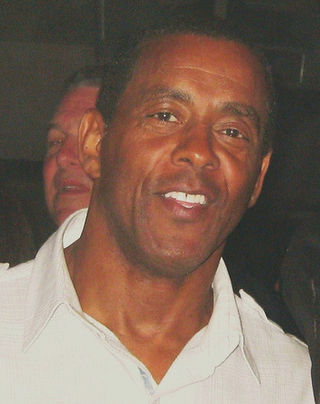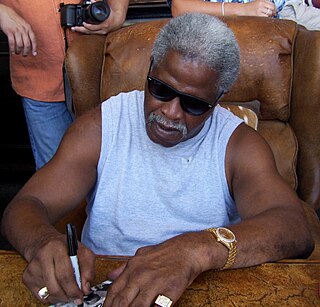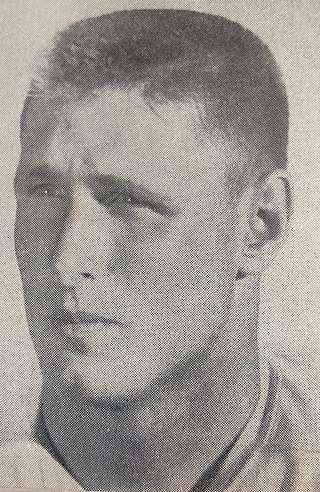
Edward Nathan George Jr. is an American football coach and former player who is the current head football coach at Tennessee State University. He played as a running back in the National Football League (NFL) for nine seasons, primarily for the Houston / Tennessee Oilers / Titans franchise.

Anthony Drew Dorsett Sr. is an American former football running back who played in the National Football League (NFL) for the Dallas Cowboys and the Denver Broncos.

Marcus LeMarr Allen is an American former football running back who played in the National Football League (NFL) for 16 seasons, primarily with the Los Angeles Raiders. Considered one of the greatest goal line and short-yard runners in NFL history, he was selected 10th overall by the Raiders in the 1982 NFL draft, following a successful college football career with the USC Trojans. He was a member of the Raiders for 11 seasons and spent his last five seasons with the Kansas City Chiefs.

Stephen Orr Spurrier is an American former football player and coach. He played ten seasons in the National Football League (NFL) before coaching for 38 years, primarily in college. He is often referred to by his nickname, "the Head Ball Coach". He played college football as a quarterback for the Florida Gators, where he won the 1966 Heisman Trophy. The San Francisco 49ers selected him in the first round of the 1967 NFL draft, and he spent a decade playing in the National Football League (NFL), mainly as a backup quarterback and punter. Spurrier was inducted into the College Football Hall of Fame as a player in 1986.

Daniel Carl Wuerffel is an American former football quarterback who played in the National Football League (NFL). He played college football for the Florida Gators, where he was a prolific passer under head coach Steve Spurrier. Wuerffel led the NCAA in touchdown passes in 1995 and 1996 and set numerous school and conference records during his career. During his senior year in 1996, he won the Heisman Trophy while leading the Gators to their first national championship. In 2013, he was inducted into the College Football Hall of Fame.

Earl Christian Campbell, nicknamed "the Tyler Rose", is an American former football running back who played in the National Football League (NFL) for eight seasons, primarily with the Houston Oilers. Known for his aggressive, punishing running style and ability to break tackles, Campbell gained recognition as one of the best power running backs in NFL history.

Desmond Kevin Howard is an American former football wide receiver and return specialist who played in the National Football League (NFL) for 11 seasons. He played college football for the Michigan Wolverines, where he was a two-time All-American, including a unanimous All-American selection in 1991, winning the Heisman Trophy. He was selected fourth overall in the 1992 NFL Draft by the Washington Redskins. Howard spent most of his career on special teams as a return specialist and holds the NFL single season record for punt return yardage. With the Green Bay Packers, Howard was named Most Valuable Player of Super Bowl XXXI after setting an NFL record for punt return yards and returning a kickoff for a 99-yard touchdown, the longest return in Super Bowl history at the time. To date, he is the only special teams player to receive the award. He was inducted to the College Football Hall of Fame in 2010.
Kenneth Leonard "Ki-Jana" Carter is an American former football running back who played in the National Football League (NFL) for eight seasons. He played college football for the Penn State Nittany Lions, where he earned consensus All-American honors and was MVP of the 1995 Rose Bowl. Carter was selected first overall in the 1995 NFL draft by the Cincinnati Bengals, but after suffering a knee tear during his first preseason game, he struggled with injuries for the remainder of his career. Missing most of his five seasons with the Bengals due to injury, Carter played his final three seasons in a limited role for the Washington Redskins and New Orleans Saints.
Timothy LaRaySmith is an American former professional football player who was a running back in the National Football League (NFL) for the Washington Redskins and the Dallas Cowboys. He played college football for the Texas Tech Red Raiders. Smith rose to fame after setting a rushing record in Super Bowl XXII.

Richard Ervins is an American former professional football player who was a running back in the National Football League (NFL) for the Washington Redskins and San Francisco 49ers. He played college football for the USC Trojans. He was selected by Washington in the third round of the 1991 NFL draft.

Charles Albert Conerly Jr. was an American professional football player who was a quarterback in the National Football League (NFL) for the New York Giants from 1948 through 1961. Conerly played college football for the Ole Miss Rebels and was inducted into the College Football Hall of Fame in 1966. He was married to Perian Conerly, a sports columnist for The New York Times.

William Orland Kilmer Jr. is an American former professional football player who was a quarterback in the National Football League (NFL) for the San Francisco 49ers, New Orleans Saints, and Washington Redskins. He was also used as a running back and wide receiver. He played college football for the UCLA Bruins, then 18 seasons as a professional. In 1964, while playing running back for the 49ers, Kilmer played a supporting role in one of the most infamous incidents in gridiron history when Vikings defensive lineman Jim Marshall ran Kilmer's fumble back 66 yards into the wrong end zone.
The 1981 NFL draft was the procedure by which National Football League teams selected amateur college football players. It is officially known as the NFL Annual Player Selection Meeting. The draft was held April 28–29, 1981, at the New York Sheraton Hotel in New York City. The league also held a supplemental draft after the regular draft and before the regular season.

William Beattie "Big Chief" Feathers was an American football player and coach of football and baseball. He played college football and college basketball at the University of Tennessee and had a seven-year career in the National Football League (NFL) playing for the Chicago Bears and two other teams.

Charles Ronald "Choo Choo" Justice was an American professional football player who was a halfback for the Washington Redskins of the National Football League (NFL). He played college football for the North Carolina Tar Heels and was inducted into the College Football Hall of Fame in 1961.
Charles Raymond White was an American football running back who played in the National Football League (NFL) for nine seasons from 1980 to 1988. He played college football for the USC Trojans, where he was a twice unanimous All-American and the winner of the Heisman Trophy. He was selected by the Cleveland Browns in the first round of the 1980 NFL Draft. He also played for the Los Angeles Rams.

The South Carolina Gamecocks football program represents the University of South Carolina. The Gamecocks compete in the Football Bowl Subdivision of the National Collegiate Athletic Association (NCAA) and the Eastern Division of the Southeastern Conference. The team's head coach is Shane Beamer. They play their home games at Williams–Brice Stadium.
The 1981 New Orleans Saints season was the Saints' fifteenth season in the National Football League. Hoping past success would bring a bright future to New Orleans the Saints hired Bum Phillips to be their new head coach. With the first pick overall the Saints draft Heisman Trophy winner George Rogers out of South Carolina. Phillips banked on Rogers giving the Saints the same boost that Earl Campbell did when Phillips drafted him out of Texas three years earlier.
The 1980 South Carolina Gamecocks football team represented the University of South Carolina as an independent during the 1980 NCAA Division I-A football season. Led by sixth-year head coach Jim Carlen, the Gamecocks compiled a record of 8–4. South Carolina was invited to the Gator Bowl, where they lost to Pittsburgh, 37–3. Gamecocks running back George Rogers won the Heisman Trophy.

Jonathan Bryce Love is an American former professional football player who was a running back in the National Football League (NFL). He played college football for the Stanford Cardinal and was selected by the Washington Redskins in the fourth round of the 2019 NFL draft, although he never played in a game with them due to a lingering issue from a knee injury he suffered at Stanford. In his youth, he was also a sprinter specializing in the 200 meters and 400 meters, earning USA Track & Field Youth Athlete of the Year honors in 2009.














